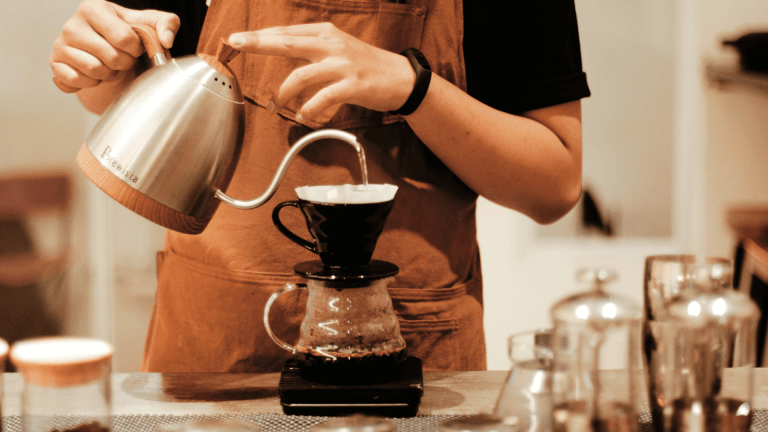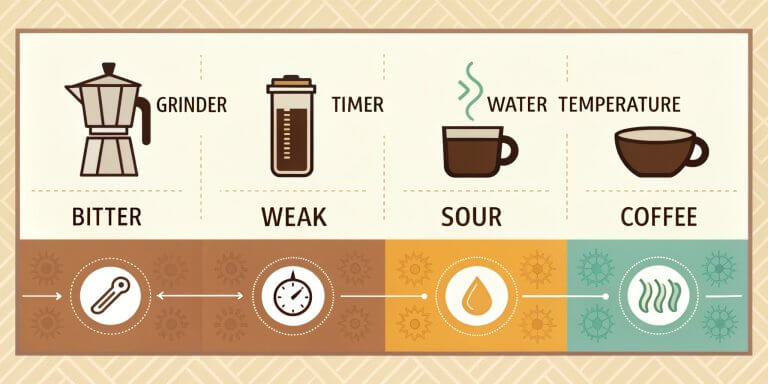
Let’s be honest; we all love a good cup of coffee. But have you ever noticed how the temperature can make or break your coffee experience? Sometimes it’s too hot, sometimes lukewarm, and then there are those magical moments when it’s just right.
Getting the coffee temperature spot-on isn’t just luck – there’s a bit of science to it! And that’s precisely what we’ll dive into in this post. Think of it as your ultimate guide to understanding how temperature affects your brew, from the moment you start brewing to that satisfying first sip. Ready to unlock the secrets to a perfect cup? Let’s go!
The Science Behind Coffee Temperature
Let’s get a little geeky for a moment and talk about extraction. It’s a fancy word, but it means pulling out all those delicious flavors from your coffee grounds. And what plays a huge role in this? You got it – temperature!
Think of it like this: hot water is like a magnet for flavor. The hotter the water, the faster it grabs onto those tasty compounds – acids, sugars, and oils – hiding in your coffee beans. But here’s the catch: these compounds dissolve at different speeds.
Acids, which give your coffee that bright, tangy kick, are the first to jump into the water. Then come the sugars, bringing in the sweetness, followed by the oils, which add body and those rich aromas we all love.
If the water is too hot, it will over-extract everything, leaving you with a bitter, burnt taste. Too cold, and you will under-extract, ending up with a weak and sour cup. The magic happens when you hit that sweet spot where everything dissolves, creating a beautifully balanced symphony of flavors.
What temperature is best for coffee?
So, what exactly is that sweet spot for brewing coffee? Most coffee experts agree that the ideal brewing temperature range sits between 195°F and 205°F (90°C to 96°C). This might seem like a narrow window, but trust me, it makes all the difference!
Why is this range so important? Think back to our extraction chat. Within this temperature range, the water is hot enough to pull out all the good stuff from your coffee grounds – the delicious acids, sugars, and oils – without going overboard and extracting those bitter compounds nobody wants. It’s like a perfectly choreographed dance where every flavor has time to shine.
But what happens if you stray outside this golden zone? If you use too hot water, you’ll reuse grounds with heat, forcing out all the compounds, including the bitter ones. You’ll end up with a harsh, burnt-tasting brew that might make you want to pucker.
On the other hand, if your water is too cold, you’ll be left with a weak and sour cup. This is because the water isn’t powerful enough to extract all the flavorful oils and sugars, leaving your coffee tasting a bit…meh.
Coffee brew temperature Ranges for Different Rost Level
Now, you might wonder if the exact temperature works for all types of coffee. The answer is: not quite! The roast level of your beans plays a significant role in how hot your water should be.
Think of it this way: lighter roasts are like tightly packed treasure chests, holding onto their delicate and complex flavors. To unlock these treasures, you need a bit more heat—a temperature closer to 205°F. This helps the water penetrate those dense beans and extract all the nuanced notes.
Darker roasts, on the other hand, are more like open baskets, with those bold, smoky flavors already out in the open. Since they’re more porous, they don’t need as much heat to release their goodness. Brewing them at a slightly lower temperature—around 195°F—prevents them from getting over-extracted and bitter.
So, here’s a quick cheat sheet for you:
Remember, these are just starting points. Feel free to experiment and see what tastes best for you!
Coffee Temperature Range for Different Brewing Methods
Did you know that your trusty brewing method also affects the ideal coffee temperature? It’s all about how long the water hangs out with the coffee grounds—the longer they mingle, the more extraction happens.
Let’s break it down by some popular brewing methods:
And then there’s the cool kid on the block: cold brew. This method throws the whole hot water thing out the window and uses room temperature or cold water to steep the coffee slowly for 12-24 hours. This creates a super smooth, low-acid coffee perfect for hot summer days.
Remember, these are just guidelines! Don’t be afraid to experiment with different temperatures within these ranges. After all, the perfect cup is the one that tastes best to you.
Tools and Techniques for Controlling Coffee Temperature
Want to brew consistently delicious coffee every time? You’ve got to master temperature control. Luckily, some handy tools can help you out!
First up, let’s talk about gooseneck kettles. They’re like the superheroes of the coffee world, giving you precise control over water temperature. Many models even have built-in thermometers so that you can hit that sweet spot every time.
Digital thermometers are another great addition to your coffee toolkit. They let you measure the temperature of your coffee slurry—the magical mix of water and coffee grounds—during brewing. You can even get fancy with an infrared laser thermometer, which measures temperature from a distance.
And here’s a simple but effective tip: preheating! Warming your mugs and brewing equipment before brewing helps minimize heat loss and keeps your coffee at the perfect temperature for longer.
The Ideal Coffee Temperature Range for Serving and Enjoyment
Okay, so we’ve nailed the brewing temperature, but what about the perfect temperature for drinking coffee? This is where things get a bit more personal. There’s no one-size-fits-all answer because everyone’s taste buds are different.
A good range to start experimenting with is between 120°F and 185°F (49°C to 85°C). Within this spectrum, you’ll discover a whole world of flavor variations!
Remember, drinking extremely hot coffee can be a safety hazard. So, let your brew cool down for a few minutes before taking that first sip. It’s worth the wait, trust me!
Conclusion
Coffee temperature is a crucial factor that significantly impacts the quality of your brew, from the initial extraction process to the final sip. The ideal temperature range for brewing sits between 195°F and 205°F (90°C to 96°C), ensuring a balanced flavor profile. However, factors like roast level and brewing method necessitate adjustments to this range.
Lighter roasts generally benefit from higher temperatures, while darker roasts fare better with slightly lower temperatures. Similarly, brewing methods like pour-over and French press require specific temperature ranges for optimal extraction. For serving, the ideal temperature is more subjective and lies between 120°F to 185°F (49°C to 85°C), with hotter temperatures accentuating boldness and cooler temperatures highlighting nuanced flavors.
Don’t be afraid to experiment with different temperatures to unlock your coffee’s full potential and discover what truly satisfies your taste buds! What are your preferred coffee temperatures for brewing and serving? Share your insights and any remaining questions below!


